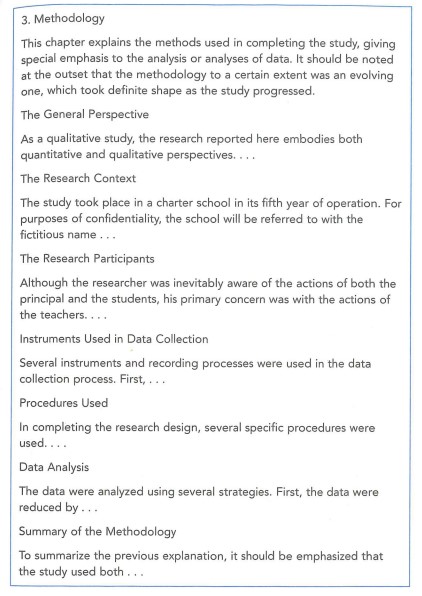
Research Report or Dissertation:
While there is no set template for writing your research report or dissertation, the most commonly used structure is:
Chapter 1: Introduction
Chapter 2: Literature review
Chapter 3: Methodology (including data analysis)
Chapter 4: Results and discussion
Chapter 5: Conclusions and recommendations
Thesis:
Again, there is no set template for writing your thesis, but the most commonly used structure is:
Chapter 1: Introduction
Chapter 2: Literature review
Chapter 3: Methodology
Chapter 4: Data analysis
Chapter 5: Results discussion and conclusions
Your particular course may have a specific structure you need to use. You should discuss this with your thesis supervisor.
Reading completed theses can also be helpful in deciding on the best structure for your thesis.
Scroll down the page to find explanations of the structure within each chapter.
The following library book is highly recommended as it contains many examples along with explanations about the writing process. You can find it at 808.066 JOY.
Joyner, R. L., Rouse, William A., & Glatthorn, A. A. (2018). Writing the winning thesis or dissertation: A step-by-step guide. Corwin.
REMEMBER: At UCOL you are expected to use APA 7 style of referencing. The APA manual also has chapters on writing styles, grammar and other useful writing tips. You can borrow this from the library.
UCOL APA7 subject guide: For detailed referencing information you can access the UCOL APA 7 Subject guide here
To access further information on this page, click on the quick links in the box below.
The introductory chapter of your thesis may require a specific structure depending on your field. Discuss this with your supervisor. Following is the structure that is most commonly used:


You may want to end the chapter with a short summary or comment about what the reader can expect in the following chapters. Again, discuss the need for this with your supervisor.
For detailed information on the literature review chapter, click on the Writing your report or thesis tab and choose the Literature review page.
Following is a possible structure of the literature review chapter based on a study examining teachers' professional development:

(Joyner et al., 2018, p. 200).
Again, the structure of you methodology chapter will depend on your type of study. However, the example below is a good starting point. Discuss the final structure with your lecturer.
A sample structure for a methodology chapter

(Joyner et al., 2018, p. 211).
Some important points to note:
The data analysis and results may be presented across one to three chapters depending on the size of the study and the type and amount of data collected.
Before writing the chapter(s) decide on:
Then decide on how you will organise the chapter(s):
Next you need to formulate all your tables and figures so you can insert them into the paragraphs as required. It will save time to do this before you start writing.
The introductory paragraph should restate your research problem, followed by an overview of the contents of the chapter.
In the first section, start with a general statement summarising your results. Make sure you refer to any table or figure as appropriate in your text rather than just inserting a table or figure and leaving it up to the reader to decide what it means. You can achieve this by making a statement followed by (see Table 1.3) or begin your sentence with Figure 3.2 shows that...
Always report the results objectively without any interpretation or modifiers.
Use this same pattern for all other sections using appropriate subheadings.
(Joyner et al., 2018).
Once you have written up your results, you need to then discuss the significant aspects of your study. Depending on the type of study, you may choose to include conclusions and recommendations where and if appropriate.
This chapter begins with a review of your results focusing on the general findings.
Tell the full story of your study in this chapter.
Outline of the discussion chapter:
(Joyner et al., 2018).
What is an appendix?
When to include an appendix:
What to include in an appendix:
Formatting an appendix:
The population of New Zealand grew by 15% in a five year period (see Appendix A).
E.g. Table A1, or Figure B2.
Each appendix should be labelled in bold in the center of the page followed by the label of the information. E.g.
Appendix
Population growth in New Zealand 2015-2021
Where there are multiple appendices, include letters after Appendix. E.g.
Appendix A
Population growth in New Zealand 2012-2015
then on the next page,
Appendix B
Population growth in New Zealand 2016-2021
These video clips are all from the same source. They were chosen because they are all around or less than 5 mins each. For more detailed and longer videos (there are many), check out YouTube.